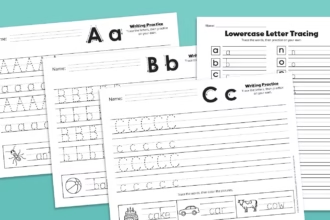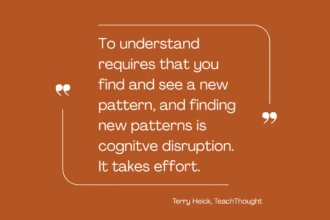In the fall of 2008, I began my teaching career as an elementary teacher. After thirteen years in the classroom with pre-kindergarten to second-grade students, I transitioned into instructional technology. I currently serve six Title I elementary schools as an instructional technology facilitator for Greenville County School District in South Carolina. In this role, I support teachers by providing effective strategies and tools to engage and motivate students. Specifically, I seek to help the teachers I work with maximize the technologies they already have access to and when needed, I introduce the educators I serve to new, innovative teaching strategies and edtech solutions.
As a father and educator of elementary-aged students, I know these are the foundational years of their educational journey. A key area I’ve focused on is helping educators grow their students’ ability to discuss content academically in their peer discussions (academic discourse) using specific content vocabulary . I believe this is a fundamental skill for students that is often overlooked. . While students might appear to be conversing, they aren’t always using the necessary vocabulary to communicate their ideas clearly and accurately. I’ve made helping educators change this dynamic one of my core missions.
As students progress throughout school, communicating and discussing content academically and effectively becomes paramount. We need to provide multiple opportunities for students to converse with peers about what they’re learning while using appropriate academic vocabulary. Through both my work as an instructional technology facilitator and in my conversations with my peers, I’ve learned many strategies for encouraging academic discourse amongst the classrooms I serve. Here are my top five strategies-and the best tools to implement them to build background knowledge and boost academic discourse with technology:
Fast and Curious with Quizizz: Robust class conversations require students to have an extensive vocabulary. The “Fast and Curious” EduProtocol, by Jon Corippo and Marlena Hebern, helps students of all ages build background knowledge and content vocabulary through a gamified process that keeps engagement high, regardless of the subject.
This EduProtocol utilizes the Quizizz platform. Teachers create or find a quiz to assess and build content knowledge. Students take a short 5-10 question quiz. The teacher quickly evaluates the data from the quiz (often a color-coded class overview in the reports), makes an on-the-fly decision about what needs re-teaching, delivers a mini-lesson based on this data, and then students immediately retake the quiz. This offers instant feedback that students require. The goal is for student scores to improve over 4-5 days, repeating the Quizizz, mini-lesson, Quizizz cycle until the class average reaches 95% or higher to show mastery. As students track their mastery, they demonstrate acquisition of the vocabulary needed for successful discussions on the topic. This active recall and repetition solidify their understanding and prepare them for speaking and writing tasks using the new terms.
Sketch & Tell with Autodraw: This EduProtocol engages students of all ages in the writing process across all subjects. How often do teachers hear, “I don’t know what to write about”, “I’m not sure how to draw that”, and/or “I’m not sure what to say”? This protocol flips the script by having students sketch and talk before they write, creating an easier entry point.
While it can be done with paper, Autodraw is an excellent digital tool. This Google-created, web-based drawing tool uses AI machine learning to help anyone create clear pictures, regardless of artistic skill. After a lesson, students will complete the EduProtocol using Autodraw to develop their understanding by drawing, speaking about their drawing, and then writing. They synthesize their learning and explain their thinking, using academic vocabulary from the lesson. Students can then share their work through a gallery walk directly from Autodraw or by inserting their downloaded image into a Google Slide presentation. This is a fantastic way to highlight student learning and encourage peer discussion.
Video with XO Let’s Go: If given a choice between a worksheet and a video, which would students pick? The majority would choose the video. Yet, without structure, students might passively watch and retain very little.
“XO Let’s Go” which is one of the instructional strategies featured in Discovery Education Experience transforms passive video viewing into an active learning experience. This versatile strategy turns standard videos into an interactive Tic-Tac-Toe game, compelling students to pay close attention. To play, students might need to identify key vocabulary words or concepts from video segments to mark their X or O, prompting them to listen for specific academic terms. This strategy also encourages note-taking on key points for post-video discussions, where students practice speaking by sharing their insights and using the newly acquired vocabulary. They learn to actively listen to both the video and their peers, deepening their content understanding. It’s no surprise this was a favorite in my classroom! While in South Carolina Discovery Education Experience is provided to schools at no cost by our state Department of Education, this powerful resource is available in most districts nationwide.
AI-Powered Songs with Suno & MagicSchool.ai: Music has a special way of helping students learn, especially younger ones. Research, including an article from the NIH, suggests music plays a “central role in the comprehension of language development” (1). While educators have known this, not everyone can compose and write songs. Historically, finding the perfect educational song was time-consuming.
Now, an app smash of Suno and MagicSchool.ai can help create custom songs that foster robust conversations. For instance, when teaching about a science topic like the parts of a plant, I can use MagicSchool.ai’s song generator to write lyrics incorporating key vocabulary (e.g., roots, stem, leaves, photosynthesis) set to the classes’ favorite genre. After reviewing for accuracy, I’ll copy and paste the lyrics into Suno to generate an original song that sounds incredibly well produced. This process is incredibly easy for teachers. Then simply play the song for the class. Students not only learn vocabulary through the song but can also participate in academic discourse by discussing what information could be added or how lyrics could be improved, perhaps even collaboratively writing new verses. What once took professional skills now takes minutes, allowing students to quickly engage with content, acquire vocabulary, and practice speaking and writing about it. (Listen to a rock version of “Monopoly Meltdown” written about the Anti Sherman Trust Act.)
AI Image Creation for Writing (Canva): Sparking student imagination is key, and pictures are a powerful way to do this. Not all students are confident artists, but they often have vivid ideas.
Canva’s AI Image generator (part of Magic Media) is a fantastic tool for this. As a class, or in small groups, students can describe the image they want to create related to a topic or story. They select the style and layout. After the AI generates the picture, facilitate a class discussion: Does the image match their vision? If not, what different terms or descriptive words (vocabulary!) can they use to get a better result? This iterative process itself builds language skills. Once satisfied, students have a unique, custom image to inspire their creative writing. This process directly supports vocabulary acquisition (through prompt engineering), speaking (discussing the image and prompts), and, ultimately, more engaged writing.
Technology integration can amplify traditional strategies, creating more engaging and effective learning experiences. Tools like Quizizz, Autodraw.com, Discovery Education Experience, Suno, MagicSchool.ai, and Canva facilitate diverse, academic discourse while promoting deeper understanding and retention in reading, listening, writing, and speaking. When combined with innovative strategies such as Fast and Curious, Sketch & Tell, XO Let’s Go, Custom Songs, and AI Generated Images, students develop not only content knowledge and vocabulary but also vital communication skills essential for their current learning and future academic success.
About the author
Coleman Brown is Instructional Technology Facilitator at Greenville County Schools, South Carolina










